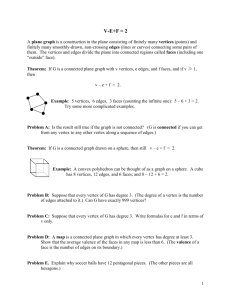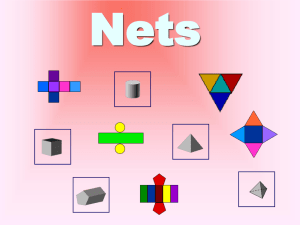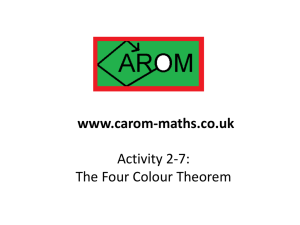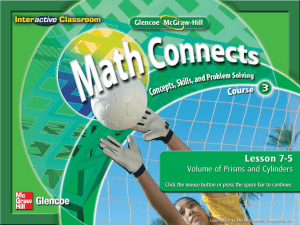Lesson 1: Faces, Vertices, and Edges
advertisement
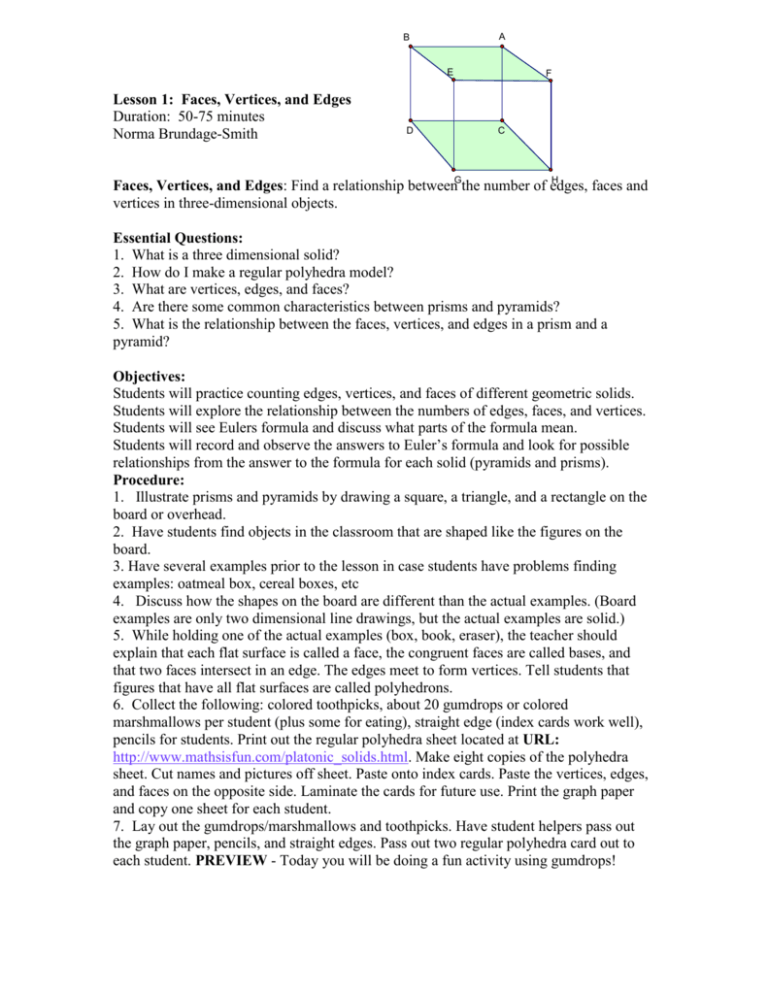
A B E Lesson 1: Faces, Vertices, and Edges Duration: 50-75 minutes Norma Brundage-Smith D F C H Faces, Vertices, and Edges: Find a relationship betweenGthe number of edges, faces and vertices in three-dimensional objects. Essential Questions: 1. What is a three dimensional solid? 2. How do I make a regular polyhedra model? 3. What are vertices, edges, and faces? 4. Are there some common characteristics between prisms and pyramids? 5. What is the relationship between the faces, vertices, and edges in a prism and a pyramid? Objectives: Students will practice counting edges, vertices, and faces of different geometric solids. Students will explore the relationship between the numbers of edges, faces, and vertices. Students will see Eulers formula and discuss what parts of the formula mean. Students will record and observe the answers to Euler’s formula and look for possible relationships from the answer to the formula for each solid (pyramids and prisms). Procedure: 1. Illustrate prisms and pyramids by drawing a square, a triangle, and a rectangle on the board or overhead. 2. Have students find objects in the classroom that are shaped like the figures on the board. 3. Have several examples prior to the lesson in case students have problems finding examples: oatmeal box, cereal boxes, etc 4. Discuss how the shapes on the board are different than the actual examples. (Board examples are only two dimensional line drawings, but the actual examples are solid.) 5. While holding one of the actual examples (box, book, eraser), the teacher should explain that each flat surface is called a face, the congruent faces are called bases, and that two faces intersect in an edge. The edges meet to form vertices. Tell students that figures that have all flat surfaces are called polyhedrons. 6. Collect the following: colored toothpicks, about 20 gumdrops or colored marshmallows per student (plus some for eating), straight edge (index cards work well), pencils for students. Print out the regular polyhedra sheet located at URL: http://www.mathsisfun.com/platonic_solids.html. Make eight copies of the polyhedra sheet. Cut names and pictures off sheet. Paste onto index cards. Paste the vertices, edges, and faces on the opposite side. Laminate the cards for future use. Print the graph paper and copy one sheet for each student. 7. Lay out the gumdrops/marshmallows and toothpicks. Have student helpers pass out the graph paper, pencils, and straight edges. Pass out two regular polyhedra card out to each student. PREVIEW - Today you will be doing a fun activity using gumdrops! Discuss the meaning of vertices (corners), faces (flat places between the edges), and edges. 8. Tell students they are going to construct two three dimensional figures. First, they have to make a drawing (blueprint) of their figure. The drawing (blueprint) will be a sketch made on the graph paper. The vertices, edges, and faces as well as the name of the regular polyhedra figure will be on this drawing. When they are done with their drawings (blueprint) of a pyramid and a prism, they must show the teacher before being allocated the materials needed for assembling their figures. 9. After the teacher has checked the drawing (blueprint) for the student's name, polyhedral names, vertices, edges, and faces, the student will be allowed to collect the toothpicks for the number of edges and gum drops/marshmallows for the number of vertices. The student will then construct the figures (one pyramid and one prism). When they are done, have them place the figures on top of their drawing (blueprint) with their name facing up. 10. After the figure is constructed, the teacher should discuss with the students what shapes they constructed, how many faces, how many edges , and how many vertices the figures has. 11. As the figures are examined and discussed, the students will fill in their charts, and exam all figures to see if a pattern develops. Figure Faces Vertices F+V Edges Total Rectangular 6 8 14 12 5 5 10 8 5 6 11 9 4 4 8 6 7 10 17 15 6 6 12 10 Prism Square Pyramid Triangular Prism Triangular Pyramid Pentagonal Prism Pentagonal Pyramid Assessment: Informal-teacher will monitor and observe; assisting where necessary Formal-students constructions and charts +2 Reflection: To promote a deeper understanding of the three-dimensional figures, provide sufficient time for students to explore and interact with other groups to observe similarities between the different pyramids and prisms. To keep the class on task and facilitate the movement of the discussion, I gave the students time to play with the marshmallows, gumdrops, and toothpicks. Each group was given enough materials in case they were tempted and ate some of their building materials. This hands-on activity helps students to manipulate the solids. The students were about to see sides that would not be visible on a two dimensional drawing. Task Appropriateness: This task was modified to provide the students with more concrete objects to works with. Instead of drawing the nets, the students will disassemble the boxes that were brought from home. The scaffolding that takes place when using the concrete objects will make the movement to the more abstract ideas of using nets of solids easier. After the examinations of the various pyramids and prisms the need for a formulas Euler’s formula should be discovered. Euler’s Formula V – E + F = 2. As fifth graders we will use V + F =E+2 GPS: M4G2 Students will understand fundamental solid figures. a. Compare and contrast a cube and a rectangular prism in terms of the number and shape of their faces, edges, and vertices. c. Construct/collect models for solid geometric figures (cubes, prisms, cylinders, etc.) M4A1 Students will represent and interpret mathematical relationships in quantitative expressions. a. Understand and apply patterns and rules to describe relationships and solve problems. Caution Points: *Emphasize that toothpick are edges * Vertices are represented by the gumdrops or marshmallow (the vertices can be eaten) *Faces are the windows *Count the edges, faces and vertices only once.


